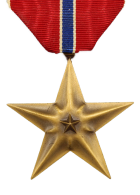Owen B. (O.B.) Hill Served with distinction in the Hq1 Communications Platoon as Battalion Message Center Chief from March 1943 to August 1945. O.B. loved his family, his country, and the Association he founded in 1975. He was dedicated to the Association and the welfare of its members. O.B. was a distinguished member of the Greatest of the Greatest Generation. He was an outstanding soldier, a trusted comrade, and a cherished friend. O.B. provided information for this summary before his death in 2002, and his WW II comrades augmented it wherever appropriate.
I was born October 8, 1921 in Fort Branch, Indiana and educated there and in Princeton. On October 21, 1940, I married Margaret Boyles. We raised two children. Linda Ann born August 12, 1941 and Joe David arrived September 14, 1948.
Pearl Harbor
Soon after Pearl Harbor, I enlisted in the Army and volunteered for airborne training. However, I had to complete basic training, before I was sent to the Parachute School at Fort Benning, GA. After I made the five jumps and qualified as parachutist, I was selected for additional training as a communications and demolition specialist. I completed the training, in March 1943, and was sent to Camp Mackall, NC for duty with the 508th Parachute Infantr,y Regiment (508th PIR). I was assigned to the Hq1 Communications Platoon, and served therein until the end of WW II.
At Camp Mackall, I received advanced infantry and airborne operations training. I participated in numerous field exercises, and made parachute jumps with equipment. Our regiment participated as the aggressor force in maneuvers in Tennessee, and someone decided we were ready for combat. At that time, I was a Sergeant, operating the Battalion Message Center. We sailed from New York, December 28. 1943. Eleven days later, we landed in Belfast, Ireland. After orientations on the local customs, physical training to restore muscles lost during the sea voyage, and weapons firing, we moved to Nottingham, England. Nottingham was an attractive city. It had ample pubs, nice people, and an exciting history. However, we trained night and day preparing for combat somewhere in Europe.
Operation Overlord
In early June 1944, we moved to an airport, and completed preparations for entry into combat. We spent many hours studying sand tables, mockups and maps, but no one knew where we would land in Europe. After we were in our C-47 aircraft, we were told the objective was in Normandy.
"The impact when I hit the water was violent. I was sinking rapidly in the muddy current of the Douve. I couldn't move and the inescapable feeling of death seized my mind and my body. Finally, my feet touched solid ground and I stood up and pushed myself out of the water. Suddenly a ray of hope - my mouth came up above the water!"
This is how O.B. Hill described his landing near Beauzeville-la Bastille in Normandy on D-Day, June 6, 1944.
O.B. Hill went on to fight at Hell's Half Acre...(Hell's Half Acre was the nickname that the 508th gave to that patch of land around the town of Chef du Pont, a small arched bridge over the Merderet river had to be taken but the 508th met fierce German resistance. This area is also known as Hill 30). After fighting off German attacks in Hells Half Acre, O.B. Hill joined up with 508th PIR troops. On June 13, 1944 he was wounded and evacuated to England. He rejoined Hq1 in December 1944 at Sissonne, France. His joyful reunion with comrades was brief.
Ardennes
On December 17, the regiment was alerted to confront a massive German force moving swiftly though the Ardennes aimed at capturing the English Channel ports. Early on December 18, Hq1 loaded into open trucks for a terribly long cold ride to Werbomont, Belgium. During an attack, January 26, O.B Hill was again wounded and evacuated. He returned to Hq1 in Heddernheim, Germany. The 508th PIR was assigned occupation duty as security forces and honor guards for General Eisenhowerís headquarters in nearby Frankfurt. In August 1945, O.B. Hill bid an emotional farewell to his comrades and started home. He was separated from the Army in September and joined his family in Southern Indiana. O. B. immediately enrolled in the University of Evansville and graduated in 1950 with a degree in Accounting and Business Management. For the next two years, he worked for the Internal Revenue Service and then entered private industry as an accountant.
In January 1979, while working for the Hughes Aircraft Company, in El Secundo, California, O.B. had a severe heart attack and survived his first triple bypass surgery. Prohibited from returning to work, O.B. retired from the Hughes Aircraft Company in 1986 and moved his family to Cathedral City, California.
O.B. Hill often said: "My most significant accomplishments were marrying Margaret, raising our children, and founding the 508th Parachute Infantry Regiment Association, WW II, 1942-1945."
Owen B. Hill was an outstanding soldier, a cheerful and helpful companion, and a dependable comrade. He earned:
Bronze Star Medal
Purple Heart Medal with Oak Leaf Cluster
Combat Infantry Badge
Invasion Arrowhead
Three battle stars
Parachute Qualification Badge with a star (Normandy jump)
Presidential Unit Citation
French and Belgian Fourrageres
Numerous defense medals including the Occupation Medal with Germany Bar.
O.B. Hill died in June 2002 and his beloved Margaret died in January 2004. They are survived by daughter Linda and son Joe, and several grandchildren. A warm thank you to the Owen's familiy. This is an excerpt from: "We Served Proudly, The Men of Hq1" - George I. Stoeckert . Thank you to the 508th Association for their help on this story.









